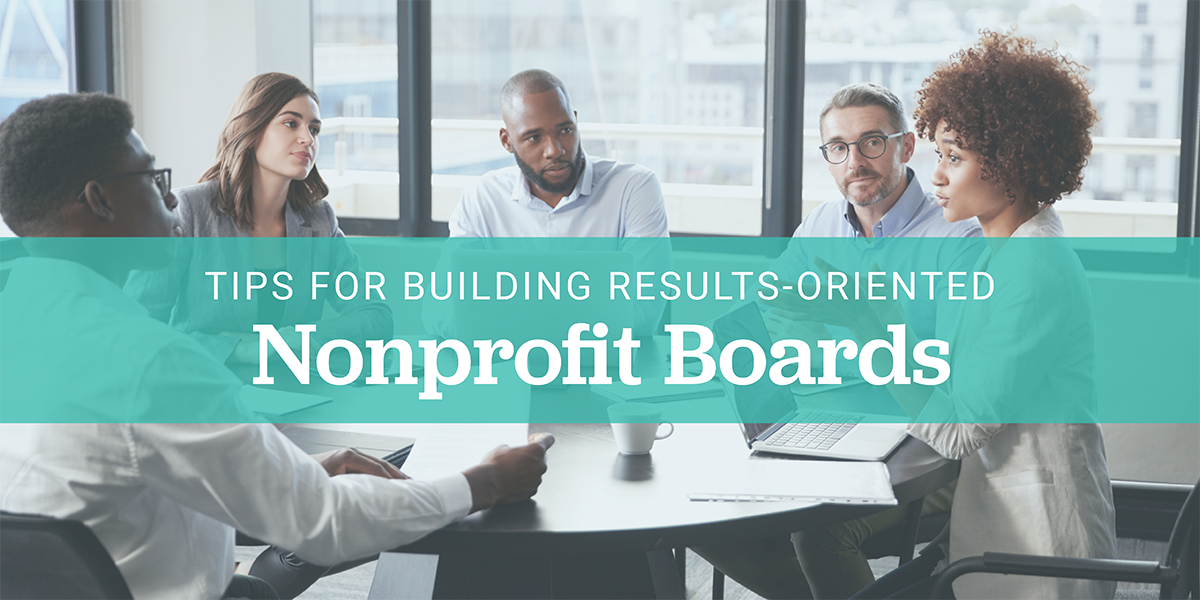Tips for Building Results-Oriented Nonprofit Boards
Lisa Hirst Carnes | May 2021

Boards play a crucial role in any nonprofit organization. Although having a board of directors is a legal requirement for nonprofits, their function is also essential for keeping an organization on track and overseeing day-to-day operations. It’s not enough, however, to simply create a board and hope for the best. You need to ensure that they are people who get results and are able to carry out the organization’s purpose. This article will explore the best strategies for creating nonprofit boards that help your organization thrive and grow.
Forming a Board: Top Considerations
Here are the primary points you need to consider when forming a nonprofit board.
How Many Board Members Do You Need?
The number of board members you have depends on several factors.
- The IRS recommends having at least three board members. The Nonprofit Law Blog points out that the IRS may reject an organization’s application for exemption if it has fewer than three board members.
- State laws may require a certain number of board members. You should check with your state to make sure you comply with their guidelines.
- Consider having an odd number of board members. This will prevent voting deadlocks.
- A larger board allows for more points of view and including people with diverse areas of expertise. More board members can also mean a larger network of potential donors. On the other hand, if a board is too large, it can make communication more complicated and make it harder to reach a consensus.
How Long Should Board Members Serve?
Another question is how long board members should serve. As there are pros and cons to both short and long terms, it’s best to strike a balance by limiting and staggering terms.
- Setting term limits ensures that the board gets a steady flow of fresh ideas. Having the same board for years can cause stagnation. You can set term limits any way you want, but two to three years is a common practice.
- Staggering terms helps maintain continuity. You don’t want to have a board composed of entirely new members. Ideally, try to stagger terms so fewer than half of your board members leave during a year.
- Board members who leave can still remain active in the organization and can help to mentor new members.
What Skills and Qualities Should Board Members Possess?
The characteristics you’ll look for depends on your organization and its goals. Here are some guidelines.
- A strong belief in the organization’s mission. This is an essential but not sufficient quality that every board member should possess.
- Knowledge of the issues and activities. In addition to enthusiasm, board members should be familiar with the major issues that the nonprofit is working on.
- Integrity. As board members are public ambassadors for the organizations, it’s important that they are loyal and trustworthy.
- An ability to commit to responsibilities. You want board members who are active and who have the time and intention to attend meetings and complete the tasks that they promise to do.
- People skills. Board members need to get along and work cohesively with the group. It also helps if they’re socially active in the community, so they are in a better position to publicize events, recruit new members, and boost fundraising.
- Diversity and inclusiveness. It’s important to consider how well a board reflects the community and the people you serve.

Board Structure and Roles
Here are the typical roles for board members.
- President or Chair —The top officer of the board who oversees all affairs and activities.
- Vice President or Vice Chair — Assists the president or chair and fills in for them when necessary.
- Secretary — Secretaries keep track of the nonprofit’s activities and organizes records. They are usually responsible for contacting members to keep them updated on meetings and other activities. One of their responsibilities may be to record or transcribe the minutes of meetings.
- Treasurer — The officer who handles accounting responsibilities. They track the flow of funds into and out of the organization. In addition to keeping accurate records, they help keep other members aware of the organization’s overall financial situation. The treasurer may be a bookkeeper or accountant, or they may outsource the actual accounting.
Committees and Why You Need Them
Nonprofits often work on a wide variety of projects. Within projects, there may be particular areas of concern, such as planning events, reaching out to potential donors, and doing research on issues. It’s not practical for everyone on the board to do everything. Committees help to focus efforts by creating smaller groups dedicated to specific activities.
Typical Committees
The size and scope of your organization will determine how many and what kind of committees you need. Some typical examples:
- Fundraising — Plans fundraising strategies such as mailings, phone calls, events, and applying for grants.
- Finance — Manage financial reports for accuracy, oversees the organization’s budget, and deals with financial decisions such as applying for credit and choosing investments.
- Membership —This committee is responsible for managing and expanding membership. They organize membership drives, remind members to renew their memberships. They may also manage the nonprofit’s website and oversee redesigns.
- Governance — Identifies needs and goals for the board, such as recruiting new board members and evaluating the performance of existing members.
- Public Relations — Contacting the media about events and activities. They may also manage online activities such as updating the website and social media.
- Ad Hoc — A nonprofit may form ad hoc committees for certain temporary needs, such as a large event or fundraising drive.
Tips For Running an Effective Board Meeting
Meetings are an important aspect of nonprofit boards. Here are some tips to help you make them as efficient and productive as possible.
- Create a schedule. Open-ended meetings tend to drag on. Start and finish on time.
- Set an agenda before the meeting. Having an agenda and sticking to it helps you keep the meeting on track.
- Insist on good attendance. Board members should understand that they are expected to attend all meetings.
- Designate a note-taker. You may have a secretary who handles this or rotate the task. You could also record the sessions and transcribe them with software.
- Impact reporting. Use visual reports that board members can understand quickly and easily.
Get the Most Value Out of Your Nonprofit Board
Creating a results-oriented nonprofit board requires attention to detail and the willingness to try new approaches. Keep in mind that the way your board operates, including how meetings are run, how tasks are assigned, and the way committees are organized, aren’t set in stone. If you observe that a certain approach isn’t working, it’s worth trying something new. You may want to enlist help with some of your strategies. ArcStone specializes in providing web design, SEM, storytelling, and other services for nonprofits and thoughtful brands. If you need help putting with your nonprofit’s impact reports, contact us.
